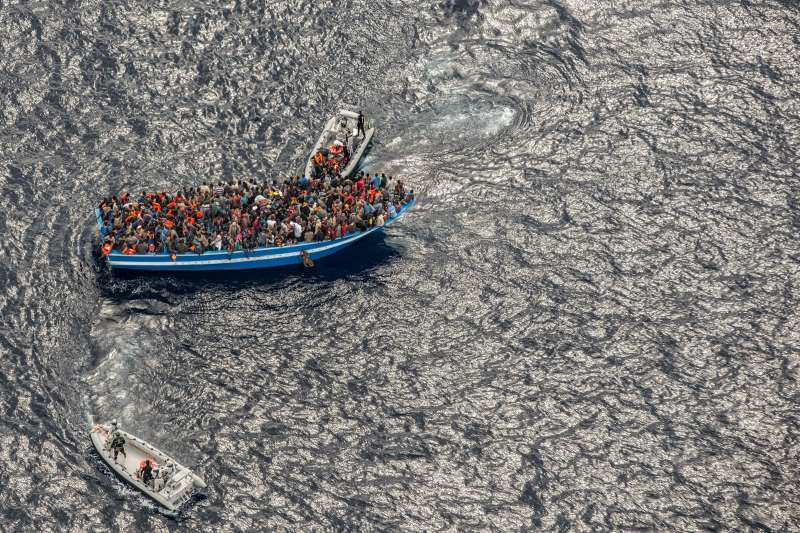On Monday, the European Commission authorized an EU naval program seeking to disrupt and destroy migrant smuggling operations and networks. Not unexpectedly, the plan has been met with a flurry of criticism, with many critics arguing that such an overemphasis on the problem of human traffickers leads to military solutions to “securitize” borders, running the risk of putting legitimate asylum seekers in the middle of a conflict zone. Critics further contend that a response that is too heavily focused on the crisis’ symptoms obscures the set of drivers that has forced so many to take the perilous journey, and consequently, its solutions.
Europe’s current strategy of focusing on military solutions against human traffickers is no doubt politically expedient. But the flow of migrants will continue unabated if more long-term efforts to address the “push” factors driving people to make the treacherous and often fatal journey across the Mediterranean from North Africa to Europe are not a part of a comprehensive strategy to tackle the crisis.
Conflict in the Middle East and Africa have produced a literally unprecedented number of displaced people


The aggregated affects of crises around the Middle East and Africa have given rise to an unprecedented numbers of refugees, internally displaced persons, and asylum seekers amounting to over 50 million people in need of security and humanitarian assistance. This is a figure not seen since World War II.
Syria remains a key driver of refugees. But conditions in the Sahel–the semi-arid band just south of the Sahara desert — are particularly prone to producing waves of migrants. According to International Organization for Migration (IOM), 86% of migrants that have died in the Mediterranean voyage have been from Sub-Saharan Africa. While Syria was the top producer of migrants in 2014, four of the top seven migrant-producing nations were from the Sahel. This year’s figures have four Sahel nations represented in the top six, with Senegal and Somali nationals outpacing Syria. Increasingly, more and more migrants are making the voyage from Nigeria, Mali, Senegal, and Somalia, where compounding pressures from climate change, poverty, environmental hazards, conflict, heavy-handed counterterrorism measures, and predatory or negligent regimes has left more than 24 million food insecure and 2.8 million displaced with little hope of returning home. Indeed, the Sahel has experienced three major food crises in the past eight years, with climate projections suggesting this level of drought and food production restrictions will soon be the new normal.
Response, adaptation, and efforts to regain livelihoods and rebuild assets is compounded and made harder by inefficient levels of national capacity and resources as four of the bottom seven countries on the Human Development Index are Sahel nations, with the remaining three being neighbors. The funding needed to address just the humanitarian needs of the Sahel crisis alone go unmet by the international community to the tune of nearly $1 billion.
Europe is unwilling to revise counterproductive immigration policies


This crisis was a foreseeable one, and one that has been brewing for years, if not decades. Over the last twenty years, Europe has experienced similar surges of incoming migrants, each one growing in size, and each matched with increasing measures to close borders and construct greater bureaucratic barriers to legal asylum status. By closing borders and making legal immigration exponentially harder, however, critics argue that the EU has inadvertently given life to a parallel smuggling economy and has necessitated migrants’ reliance on smugglers and their nefarious networks, enhancing smugglers’ strength and reach. The most recent uptick in migrants came in 2011 and was quickly followed by a closing of land migratory routes, effectively forcing more to take the difficult, and increasingly fatal journey by sea in following years.
Libya, Destabilized
![[Essam Mohamed] Fighters for Libya's interim government rejoice after winning control of the Kadhafi stronghold of Bani Walid.](https://undispatchnew.wpengine.com/un-content/uploads/2015/05/NTC_fighters_claim_Bani_Walid-1024x768.jpg)
![[Essam Mohamed] Fighters for Libya's interim government rejoice after winning control of the Kadhafi stronghold of Bani Walid.](https://undispatchnew.wpengine.com/un-content/uploads/2015/05/NTC_fighters_claim_Bani_Walid-1024x768.jpg)
Following the 2011 multilateral, Western military intervention to end the reign of Muammar Gaddafi, Libya was sent into a destabilizing tailspin resulting in state collapse, where today multiple militias vie for control of Libya. Instability and lawlessness proved to be a conducive environment for the growth of criminal networks that capitalized on Libya’s now defunct border control measures. Word of Libya’s relatively unchallenged out-migration from its shores spread across the Sahel beckoning many to the migratory route hub. Prior to 2011, Europe’s inflow migration from Libya was in the low tens of thousands. In 2011 this number swelled to more than 63,000 and by 2014 this number grew to nearly 220,000 according to analysis conducted by the BBC.
Solving the political juggernaut of Libya alone will not solve the broader challenges of the migrant crisis. The development of criminal networks did not manifest in a vacuum, rather these networks were assembled to meet a demand—passage to Europe where people could rebuild their lives. This demand cannot be stemmed until the international community addresses the larger implications of the first two drivers.
